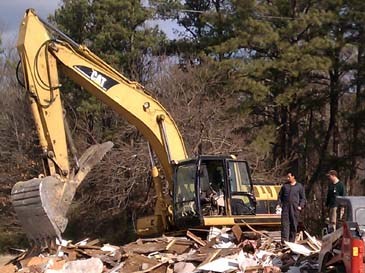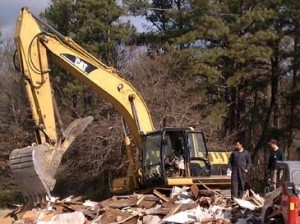Love Bulldozers, Hate Blight

Following a smashing PowerPoint on the huge screen at Bay District Volunteer Fire Department and after announcing Mike’s Bar was gone as well, Robin Finnacom, CEO of the Community Development Corporation in Lexington Park confessed, “I love bulldozers.”
Members of the Lexington Park Business and Community Development Association agreed with applause. And this was still days prior to demolition of two dilapidated houses near the kayak launch in Great Mills at the southern reaches of the Bay District.
Demolitions remain a mainstay of community development corporations as they fight blight in communities across the nation. While redevelopment bulldozers have not always been welcomed, the transforming of deteriorated segments of communities into art and retail and business centers demonstrates a history of bulldozer successes as well. This is what St. Mary’s County’s Community Development Corporation is aiming for.
“Those kind of blighted properties hold back Lexington Park,” Ms. Finnacom said of the old Besche gas station formerly at the corner of Chancellor’s Run and Great Mills Road and of Mike’s Bar on Great Mills Road. “Each one of these demolitions is a huge victory.”
It is a victory the development corporation wants expanded.
Seeking punitive action on privately owned properties is tough, even when a property is devastating surrounding property values. The balance is tough to achieve. Still, any neighbor of a rundown building, let alone a blighted one, can attest that property rights extend beyond property lines. It can only take one derelict property to slash the value of a whole village. Where does your right to a single, annual trip to the dump become your neighbor’s right to a fresher aroma?
Conceding the difficulties, the Lexington Park corporation will approach county government this year about including a definition in the zoning ordinance identifying what is a blighted property. Ultimately the goal is to use the zoning ordinance to control blight in Lexington Park.
An intensely detailed description of blight has been crafted and a copy printed on the back of the association’s January agenda. Ms. Finnacom was forthcoming about the need for business and community support of the law.
While the crafted definition is new, everyone who attends association meetings knows what blight is. Blighted buildings, usually owned by absentee landlords, are a constant agenda item and off-agenda subject.
The purchase, bankruptcy, deterioration and now purchase out of bankruptcy of the Lore property was followed closely. Business owners and residents openly expressed fear that such a significant piece of commercial property could fall into disrepair and relief tipping into glee at its recent sale.
A house on Midway Drive is a recognized blighted property. No next door neighbor could possibly sell their home, Ms. Finnecom said and received immediate nods of recognition. County planner Jeff Jackman admitted the house was posted on his “Challenges and Gems” album at the Lexington Park Development District’s Facebook page.
Colony South neighborhood association meetings also focus on absentee landlord properties which in addition to demolishing property values tend to draw criminal activity.
Absolutely, concur community development corporations and law enforcement officials. The greatest criminal trafficking problems in neighborhoods come from properties with distant owners.
There are various legal methods used across the country to give jurisdictions the power to demand property owners meet the general expectations of the neighborhoods. Some laws force landlords to hold some responsibility for how their tenants use their property. Other laws require properties be maintained to not reduce the property values of the surrounding neighborhood. The corporation’s blight definition seeks the latter.
























